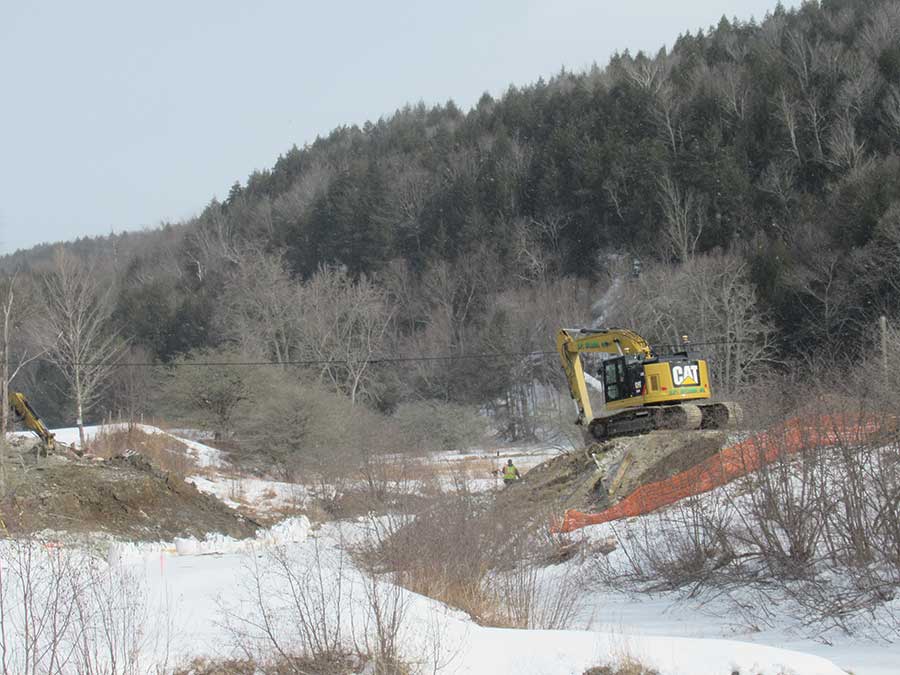Contractors hope rail trail to be completed this year
Bridge construction spanning Black Creek in Bakersfield
For five years, people have been able to walk, run, cycle, ski and snowmobile along a 17-mile stretch of Lamoille Valley Rail Trail between Morristown and Cambridge.
That’s only a taste of the entire 93-mile corridor, which runs between St. Johnsbury and Swanton. The state of Vermont has fast-tracked the trail’s completion, with nearly $15 million in projects ready to go as soon as the ground thaws.The state is eyeing a November completion date on what state officials say will be the longest rail trail in New England.
Nearly 45 miles have been completed, with sections on either side and that 17-mile swath through the heart of Lamoille County that has proved popular over the past several years.
The Vermont Association of Snow Travelers did the bulk of the work, completing 33 miles through years of fundraising and volunteer efforts, until the Vermont Agency of Transportation announced in 2018 it would finish the trail, with promises from Gov. Phil Scott to have the state fully fund the completion.
The state is scheduled to take over management July 1.
While the goal of VAST was to get the thing finished, transportation officials say the state’s priority when it takes over management is the trail’s longevity. It’s one thing to finish something but an entirely different thing to regularly maintain 93 miles of trail.
Other Vermont rail trails have enjoyed success within their communities, too. The Missisquoi Valley trail, at 26 miles running between Richford and St. Albans, predates the one in the Lamoille Valley, and remains the longest uninterrupted rail trail in Vermont, for now.
During a question-and-answer session last week, Michelle Boomhower with VTrans said the agency taking over management for the four rail trails — the other two are the Beebe Spur along the eastern shore of Lake Memphremagog in Newport and the Delaware and Hudson, in the south-central portion of Vermont, roughly between Castleton and Poultney — will ensure the trails’ existence far into the future, by making them part of the transportation agency’s annual budget.
She said, though, it was VAST and its army of volunteers that laid the foundation.
“They view the long-term opportunity for this to be a terrific resource, not only for the local communities along the rail trail, but also for visitors to the state of Vermont who are interested in recreation of this nature,” Boomhower said.
There are currently four active projects — work has stopped during the winter — to finish the trail. One of the sections most in need of bridge and bed work is the stretch between Hardwick and Morristown, which will be handled by S.D. Ireland. Because of the larger number of bridges that need work in this section, it is the most expensive stretch, contracted for $6.9 million, and scheduled to be finished by Nov. 10.
Cambridge construction outfit G.W. Tatro is managing an 18-mile segment between Danville and Hardwick at the cost of $2.2 million and it will be done by Nov. 12.
Construction on the final section, between Cambridge and Sheldon, is being managed by Dirt Tech, at a cost of $2.4 million, also expected to be done by Nov. 12. J.P. Sicard has been awarded the contract for many bridges throughout the rail trail’s length. That work will cost about $3.4 million.
All in all, the Lamoille Valley Rail Trail features five tunnels, 53 bridges, 96 crossings and 525 culverts. It passes through 18 communities and 36 total miles of it are adjacent to the Lamoille River.
The state has a “crowdsource input tool” on the Lamoille Valley Rail Trail section of the VTrans website. One of the comments made touts the trail as a safe corridor for cyclists.
Said the commenter, “To be able to ride for mile after mile without a single motor vehicle ‘event’ is a huge relief, and a benefit I travel long distances to enjoy!”
Editor’s note: Tommy Gardner is news editor for the Stowe Reporter and News and Citizen, and a former editor of Basement Medicine. This article first appeared in the News and Citizen.



